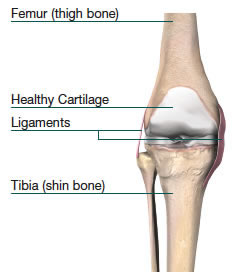Arthritis pain affects more than 40 million Americans.1 If you’re reading this website, you may be one of them. There are many causes of knee pain and there are a variety of treatment options. This website will review the causes and treatments of knee pain, highlighting more conservative knee treatment. Alleviating the pain and restoring mobility in your knee may allow you to do the simple things — from walking to gardening, even playing with your grandchildren, and most importantly, just enjoying life again. Information is the first step toward potential relief from joint pain.
Knee Anatomy and Function
The knee is the largest joint in the body and is central to nearly every routine activity. The knee joint is formed by the ends of 3 bones: the lower end of the thigh bone (femur), the upper end of the shin bone (tibia), and the knee cap (patella). Thick, tough tissue bands called ligaments connect the bones and stabilize the joint. A smooth, plastic-like lining called cartilage covers the ends of the bones and prevents them from rubbing against each other, allowing for flexible and nearly frictionless movement. Cartilage also serves as a shock absorber, cushioning the bones from the forces between them. Finally, a soft tissue called synovium lines the joint and produces a lubricating fluid that reduces friction and wear.

